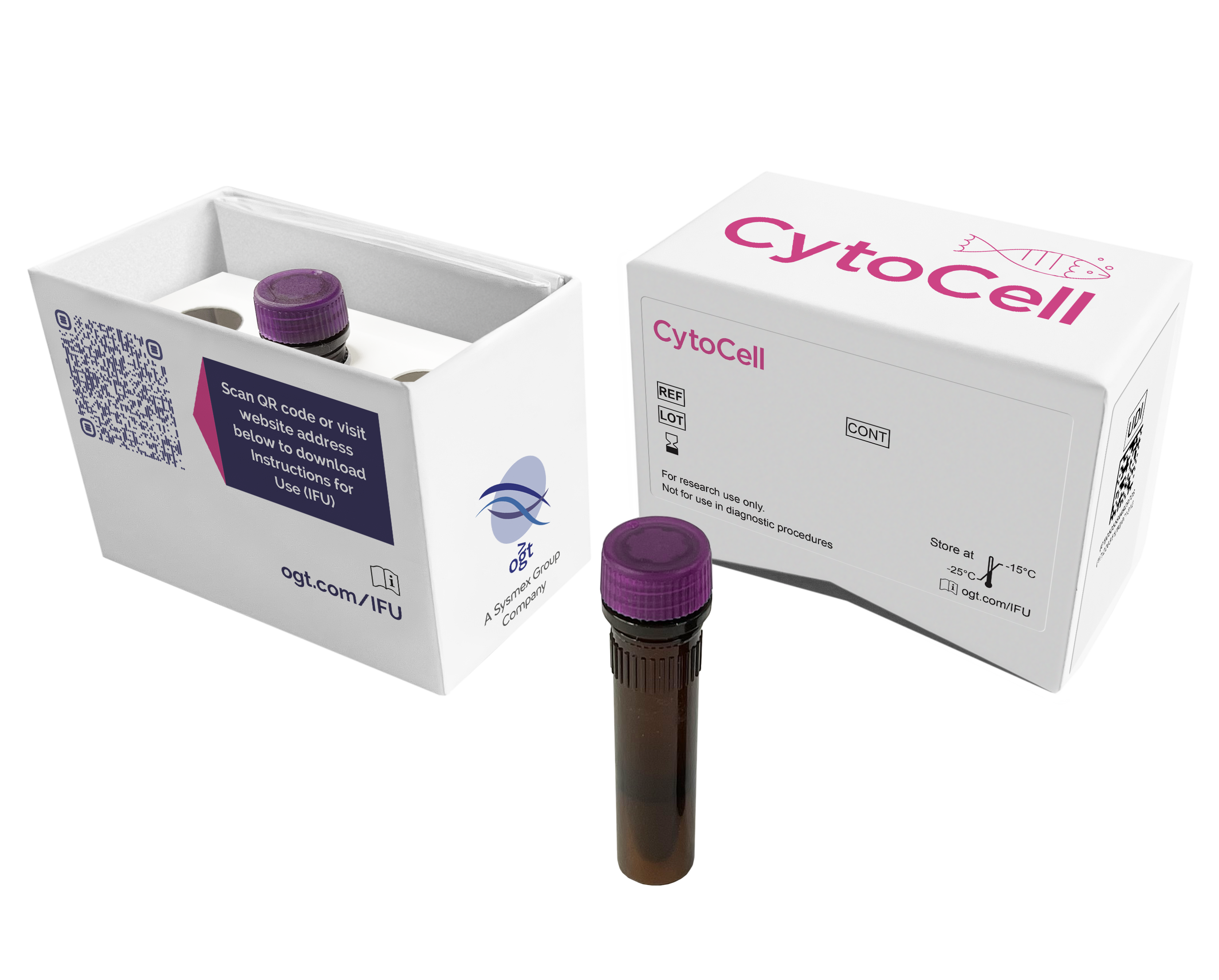
The TWIST1 probe is 179kb, labelled in red and covers a region including the entire TWIST1 gene and flanking DNA. The Williams-Beuren region probe, labelled in green, consists of three non-overlapping clones (148kb, 144kb and 204kb), which cover much of the deletion region.
Saethre-Chotzen syndrome is a rare, congenital, autosomal dominant disorder characterised by craniofacial and limb abnormalities1.
The incidence of this syndrome is estimated to be 1 in 25,000-50,000 live births, though due to the phenotype often being very mild, it is possible that the syndrome is under diagnosed1. The identification of TWIST1 (a basic helix-loop-helix transcription factor on chromosome band 7p21.1) as a causative gene2,3 has proved invaluable for the diagnosis of this phenotypically variable disorder1.
Williams-Beuren Syndrome (WBS) is a rare neurodevelopmental disorder caused by a deletion (approx. 1.5-1.8Mb in size, containing around 28 genes6) within chromosome band 7q11.234. The incidence of this syndrome is estimated at 1 in 7,500 to 20,000 live births5,6.
Patients display a distinctive ‘elfin’ facial appearance, connective tissue problems, SupravalVular Aortic Stenosis (SVAS), growth retardation, renal anomalies, transient hypercalcaemia, hyperacusis and mental retardation7. Haploinsufficiency or hemizygosity of the elastin (ELN) gene has been identified as being responsible for the SVAS8,9 but none of the other clinical features of the syndrome have been unequivocally attributed to specific genes within the WBS deleted region. These genotype-phenotype correlations are made more difficult in WBS patients as the deletion has also been shown to have an effect on normal copy number genes that neighbour the deletion breakpoints10.
The Saethre-Chotzen/Williams-Beuren Combination contains a red probe that covers the TWIST1 gene for Saethre-Chotzen syndrome and a green probe covering the area around the ELN gene in the Williams-Beuren syndrome deleted region.
In vitro diagnostic (IVD)
→ English/Français/Italiano/Deutsch/Español
→ Polski
Research use only (RUO)
Find certificate of analysis documentation for our CytoCell FISH probes
Our lab has been using a wide range of CytoCell FISH probes for a number of years, and have been increasing this range all the time. The probes have clear bright signals and show good reproducibility. CytoCell provides fast delivery of catalogue probes, and are very responsive when we have any queries or problems with their products.

Bridget Manasse
Addenbrookes Hospital, Cambridge University Hosiptals NHS Foundation Trust, UK
In our hands, CytoCell FISH probes have proven to be of the highest quality with bright, easy to interpret signals, thus providing confidence in our results. OGT's customer support is outstanding, as their staff are extremely knowledgeable and truly care about their customers and their customers’ needs.

Jennie Thurston
Director of Cytogenetics, Carolinas Pathology Group, USA
I first came across CytoCell FISH probes in a previous lab I worked in and I was struck by the quality of the products. Since this time, I have been recommending and introducing CytoCell probes across all application areas — now they are the primary FISH probes used in our lab. They have an excellent range of products and their ready-to-use reagent format saves considerable time.

Elizabeth Benner
Medical Technologist, University of Arizona Health Network, USA
We have been working with CytoCell fish probes for two decades because of their excellent clarity and intensity regardless of the size of the probe. It is so clear and simple to detect.
Dr. Marina Djurisic
Head of Laboratory of Medical Genetics, Mother and Child Health Care Institute of Serbia “Dr Vukan Cupic”, Serbia
The quality and consistency of CytoCell’s probes means I can trust the results, and my clients get their results in a timely manner.

Dr. Theresa C. Brown
Director, Cytogenetics Laboratory, Hayward Genetics Center, Tulane University School of Medicine, USA
It was very important for us to have more consistent results with our probes — easy-to-read bright signals and a range of vial sizes, which is much more cost-effective.

Janet Cowan, PhD
Director of the Cytogenetics Laboratory, Tufts Medical Center, USA
Not only do CytoCell offer an extensive range of high-quality FISH probes, the customer support is also excellent — providing fast access to all the probes I need. The probes are highly consistent with bright signals allowing easy scoring of results.
Dr. Eric Crawford
Senior Director, Genetics Associates Inc., USA
The quality and reproducibility of results using the CytoCell kit has been vital in accurately detecting co-deletions in our glioma investigations. We now have a cost-effective test that we can rely on that is also easy to use and interpret. We've been consistently impressed with this kit - not to mention the support offered by OGT's customer service, and have completely transitioned over to CytoCell probes.
Gavin Cuthbert, FRCPath
Head of Cancer Cytogenetics, Northern Genetics Servce, Newcastle, UK